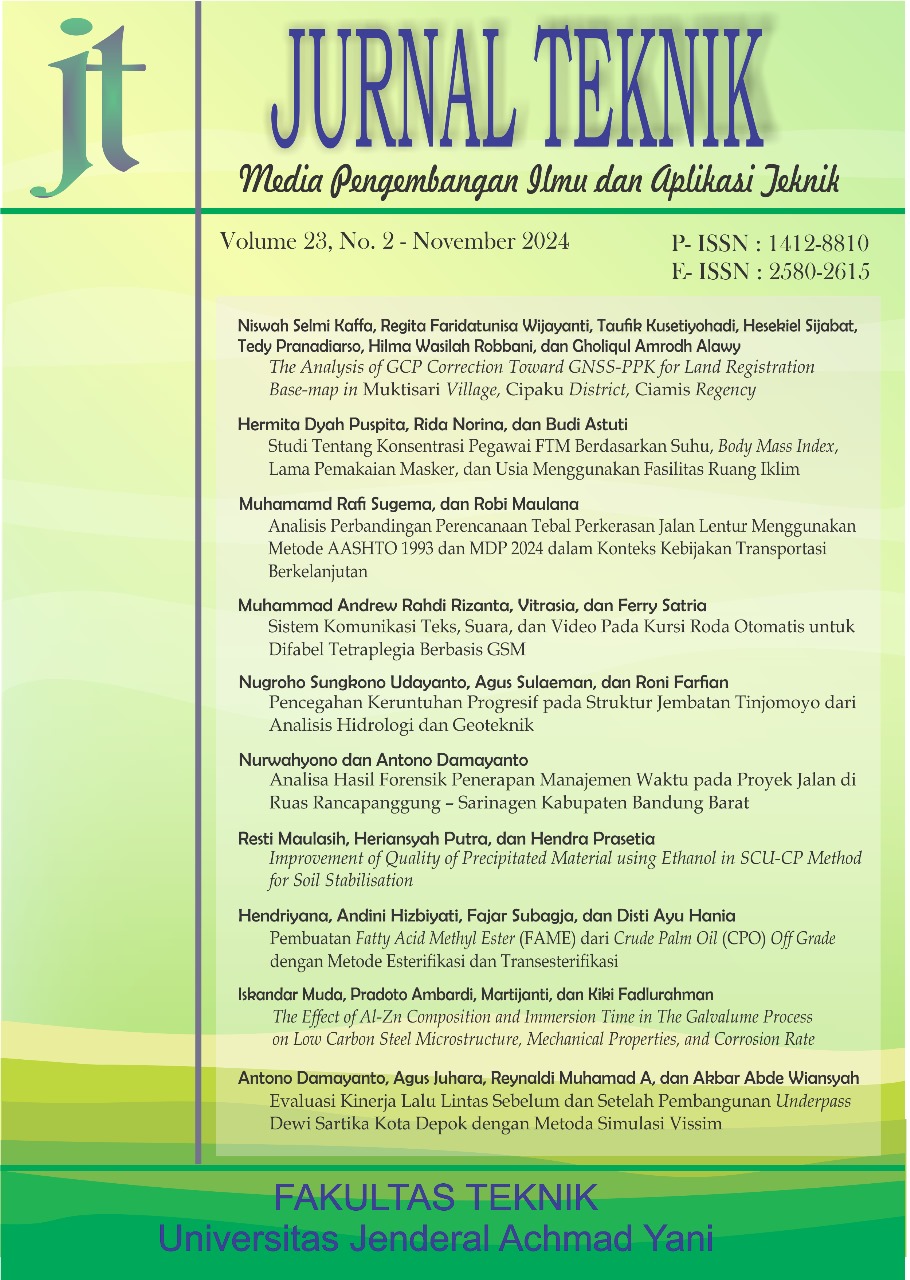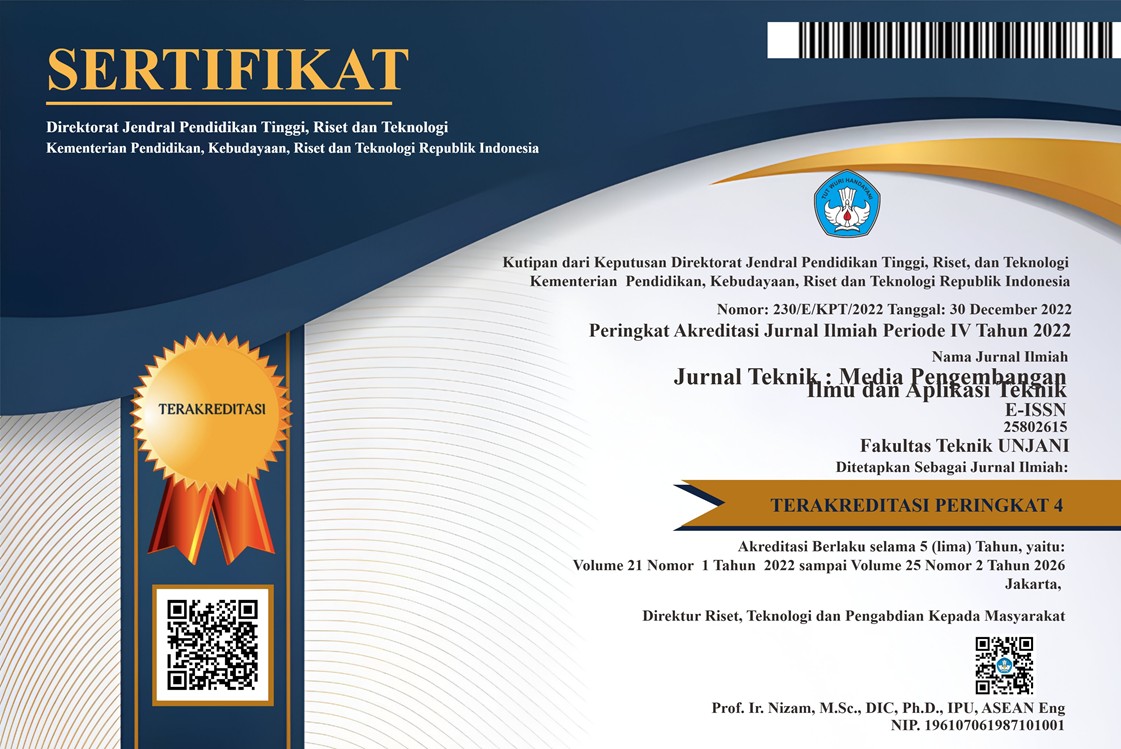Analisis Perbandingan Perencanaan Tebal Perkerasan Jalan Lentur Menggunakan Metode AASHTO 1993 dan MDP 2024 dalam Konteks Kebijakan Transportasi Berkelanjutan
DOI:
https://doi.org/10.55893/jt.vol23no2.683Keywords:
AASHTO 1993, MDP 2024, sustainable transportation, pavement thickness, environmental impactAbstract
Flexible pavement plays a vital role in the development of efficient and environmentally friendly transportation infrastructure. In Indonesia, the AASHTO 1993 method has long been used as the standard guideline for flexible pavement thickness design. However, with the introduction of the 2024 Pavement Design Manual, which is more adaptive to local conditions, a comparative evaluation of the two methods is crucial, especially in supporting sustainable transportation policies. This study aims to analyze how each method contributes to reducing environmental impact, material usage, and energy efficiency. Through an integrative literature review, the study finds that MDP 2024 offers a more efficient pavement design in terms of material and energy usage while supporting carbon emission reductions. Nevertheless, challenges such as the adoption of eco-friendly technologies and the limited availability of geotechnical data still need to be addressed. This study suggests that MDP 2024 be utilized to support more sustainable transportation policies in Indonesia.
References
Abdollahi, S. F., Lanotte, M., Kutay, M. E., & Bahia, H. (2023). AASHTO 1993 Plus: an alternative procedure for the calculation of structural asphalt layer coefficients. International Journal of Pavement Engineering, 24(2). https://doi.org/10.1080/10298436.2022.2118273
American Association of State Highway and Transportation Officials. (1993). AASHTO 1993.
Daba S. Gedafa, Mustaque Hossain, Stefan Romanoschi, & Andrew J. Gisi. (2013). Flexible Pavement Design Simulation Using Mechanistic-Empirical Pavement Design Guide. Journal of Civil Engineering and Architecture, 7(11). https://doi.org/10.17265/1934-7359/2013.11.005
Direktorat Jenderal Bina Marga. (2024). Manual Desain Perkerasan 2024.
El-Ashwah, A. S., El-Badawy, S. M., & Gabr, A. R. (2021). A Simplified Mechanistic-Empirical Flexible Pavement Design Method for Moderate to Hot Climate Regions. Sustainability, 13(19), 10760. https://doi.org/10.3390/su131910760
Huang, Y. (2004). Pavement Analysis and Design. Pearson Prentice Hall.
Mubaraki, M., Osman, S. A., & Sallam, H. E. M. (2019). Effect of RAP content on flexural behavior and fracture toughness of flexible pavement. Latin American Journal of Solids and Structures, 16(3). https://doi.org/10.1590/1679-78255516
Qiao, Y., Wang, Z., Meng, F., Parry, T., Cullen, J., & Liu, S. (2022). Evaluating the economic and environmental impacts of road pavement using an integrated local sensitivity model. Journal of Cleaner Production, 371, 133615. https://doi.org/https://doi.org/10.1016/j.jclepro.2022.133615
Solanki, P., & Zaman, M. (2017). Design of semi-rigid type of flexible pavements. International Journal of Pavement Research and Technology, 10(2), 99–111. https://doi.org/10.1016/j.ijprt.2016.10.004
Styer, J., Tunstall, L., Landis, A., & Grenfell, J. (2024). Innovations in pavement design and engineering: A 2023 sustainability review. Heliyon, 10(13), e33602. https://doi.org/https://doi.org/10.1016/j.heliyon.2024.e33602
Zhao, Y., Goulias, D., & Peterson, D. (2021). Recycled Asphalt Pavement Materials in Transport Pavement Infrastructure: Sustainability Analysis & Metrics. Sustainability, 13(14). https://doi.org/10.3390/su13148071
Additional Files
Published
Issue
Section
License
Copyright (c) 2025 Muhamamd Rafi Sugema, Robi Maulana

This work is licensed under a Creative Commons Attribution-NonCommercial-ShareAlike 4.0 International License.
Penulis yang menyerahkan artikel di Jurnal Teknik: Media Pengembangan dan Aplikasi Teknik untuk keperluan publikasi telah mengetahui bahwa Jurnal Teknik: Media Pengembangan dan Aplikasi Teknik memberikan akses terbuka terhadap konten untuk mendukung pertukaran informasi mengenai ilmu pengetahuan, sesuai dengan penerbitan daring yang berbasis Open Access Journal dan mengikuti Creative Commons Attribution 4.0 International License. Sehingga penulis setuju dengan ketentuan-ketentuan berikut:
1. Penulis memegang hak cipta dan memberikan hak publikasi pertama kepada pihak jurnal dengan pekerjaan secara bersamaan
di bawah Creative Commons Attribution 4.0 International License yang memungkinkan orang lain untuk berbagi pekerjaan
dengan pengakuan kepengarangan karya dan publikasi pertama artikel tersebut di Jurnal Teknik: Media Pengembangan dan
Aplikasi Teknik.
2. Penulis dapat melakukan perjanjian tambahan untuk hak distribusi non-eksklusif artikel yang telah diterbitkan di jurnal ini
(misalnya, posting ke sebuah repositori institusi atau menerbitkannya dalam sebuah buku), dengan mengakui bahwa
publikasi pertama dilakukan di Jurnal Teknik: Media Pengembangan dan Aplikasi Teknik.
3. Penulis diizinkan dan didorong untuk menyebarkan karya mereka secara daring (misalnya, dalam repositori institusi atau
laman web penulis) setelah artikel terbit (proses penerbitan artikel selesai). Hal ini terkait dengan imbas dari pertukaran
informasi yang produktif (Lihat Pengaruh Open Access).












